Contaminants in the Soil and Typical Crops of the Pannonian Region of Slovenia
Abstract
1. Introduction
2. Materials and Methods
2.1. Sample Collection and Preparation
2.2. Sample Preparation for SEM
2.3. SEM and EDS Analyses
2.4. Analysis of the Elemental Composition
2.5. Analyzing Microplastic Contents
3. Results
3.1. Elemental Composition of Soil Samples
3.2. Microplastic Content in Soil Samples
3.3. Crop Sample Results
4. Discussion
4.1. Soil Sample Results
4.2. Crop Sample Results
5. Conclusions
5.1. Elemental Composition of Soil
5.2. Microplastic Contamination
5.3. Analytical Techniques
Supplementary Materials
Author Contributions
Funding
Data Availability Statement
Conflicts of Interest
References
- Mandic, O.; de Leeuw, A.; Bulić, J.; Kuiper, K.F.; Krijgsman, W.; Jurišić-Polšak, Z. Paleogeographic evolution of the Southern Pannonian Basin: 40Ar/ 39Ar age constraints on the Miocene continental series of Northern Croatia. Int. J. Earth Sci. 2012, 101, 1033–1046. [Google Scholar] [CrossRef]
- Zelnik, I.; Čarni, A. Plant species diversity and composition of wet grasslands in relation to environmental factors. Biodivers. Conserv. 2013, 22, 2179–2192. [Google Scholar] [CrossRef]
- Mócsy, A. Pannonia and Upper Moesia (Routledge Revivals): A History of the Middle Danube Provinces of the Roman Empire, 1st ed.; Routledge: London, UK, 1974. [Google Scholar] [CrossRef]
- Bedrač, M.; Bele, S.; Brećko, J.; Dvoršak, A.H.; Kožar, M.; Ložar, L.; Moljk, B.; Telič, V.; Tanja Travnikar, B.Z. Poročilo o Stanju Kmetijstva, Živilstva, Gozdarstva in Ribištva 2022; Ljubljana, Slovenia, 2022. Available online: https://www.gov.si/assets/ministrstva/MKGP/Dokumenti-/Stanje-v-kmetijstvu-2022/ZP_2022_splosno-+-priloge.pdf (accessed on 15 May 2024).
- Žarko, L.; Lorenčič, A. Strategije in Prakse Energetske Oskrbe v Sloveniji; Aleš, G., Ed.; ZALOŽBA INZ: Ljubljana, Slovenia, 2015; ISBN 2350-5656. [Google Scholar]
- Bräuer, K.; Geissler, W.H.; Kämpf, H.; Niedermannn, S.; Rman, N. Helium and carbon isotope signatures of gas exhalations in the westernmost part of the Pannonian Basin (SE Austria/NE Slovenia): Evidence for active lithospheric mantle degassing. Chem. Geol. 2016, 422, 60–70. [Google Scholar] [CrossRef]
- Markič, M.; zavod Slovenije, G. Premogi v Sloveniji ter prikaz njihovih nahajališč na šestih izbranih kartah. Available online: https://www.geo-zs.si/PDF/PeriodicnePublikacije/Premogi_v_Sloveniji_in_njihova_nahajalisca_-_Posodobljeno_2014.pdf (accessed on 15 May 2024).
- Edwards-Jones, G. Symposium on “Food supply and quality in a climate-changed world” Does eating local food reduce the environmental impact of food production and enhance consumer health? Proc. Nutr. Soc. 2004, 69, 582–591. [Google Scholar] [CrossRef] [PubMed]
- Cvijanović, D.; Ignjatijević, S.; Tankosić, J.V.; Cvijanović, V. Do local food products contribute to sustainable economic development? Sustainability 2020, 12, 2847. [Google Scholar] [CrossRef]
- Coelho, F.C.; Coelho, E.M.; Egerer, M. Local food: Benefits and failings due to modern agriculture. Sci. Agric. 2018, 75, 84–94. [Google Scholar] [CrossRef]
- Hardesty, S.D. The growing role of local food markets. Am. J. Agric. Econ. 2008, 90, 1289–1295. [Google Scholar] [CrossRef]
- Hempel, C.; Hamm, U. How important is local food to organic-minded consumers? Appetite 2016, 96, 309–318. [Google Scholar] [CrossRef]
- Lombi, E.; Wenzel, W.W.; Adriano, D.C. Soil contamination, risk reduction and remediation. Land Contam. Reclam. 1998, 6, 183–197. [Google Scholar] [CrossRef]
- Khan, M.A.; Khan, S.; Khan, A.; Alam, M. Soil contamination with cadmium, consequences and remediation using organic amendments. Sci. Total Environ. 2017, 601–602, 1591–1605. [Google Scholar] [CrossRef]
- Kowalska, J.B.; Mazurek, R.; Gąsiorek, M.; Zaleski, T. Pollution indices as useful tools for the comprehensive evaluation of the degree of soil contamination—A review. Environ. Geochem. Health 2018, 40, 2395–2420. [Google Scholar] [CrossRef] [PubMed]
- Chen, L.; Fang, L.; Yang, X.; Luo, X.; Qiu, T.; Zeng, Y.; Huang, F.; Dong, F.; White, J.C.; Bolan, N.; et al. Sources and human health risks associated with potentially toxic elements (PTEs) in urban dust: A global perspective. Environ. Int. 2024, 187, 108708. [Google Scholar] [CrossRef]
- Neža, F.; Leštan, D. Možnost uresni č evanja koncepta “č lovekove varnosti” v razmerah prekomerne obremenitve okolja—Primer Prekmurja. Acta Agric. Slov. 2008, 91, 157–166. [Google Scholar]
- Van Straalen, N.M. Assessment of soil contamination—A functional perspective. Biodegradation 2002, 13, 41–52. [Google Scholar] [CrossRef]
- Rashid, A.; Schutte, B.J.; Ulery, A.; Deyholos, M.K.; Sanogo, S.; Lehnhoff, E.A.; Beck, L. Heavy Metal Contamination in Agricultural Soil: Environmental Pollutants Affecting Crop Health. Agronomy 2023, 13, 1521. [Google Scholar] [CrossRef]
- Karo Bešter, P.; Vrščaj, B. Vsebnost težkih kovin v tleh in vrtninah, ki so pridelane na izbranem območju občine Kanal ob Soči. Agricultural Institute of Slovenia. 2015. Available online: https://www.obcina-kanal.si/mma/2015_11-OnesnazenjeTalKanal.KoncnoPorocilo.pdf/2015121111192477/?m=1449829165 (accessed on 15 May 2024).
- Nives, K.; Melita, S. Vsebnost Težkih Kovin v Tleh in Rastlinah na Kmetijskih Površinah v Šaleški Dolini: Končno Poročilo; Agricultural Institute of Slovenia: Velenje, Slovenia, 2001. [Google Scholar]
- Al Sayegh-Petkovšek, S.; Pokorny, B. Vsebnost Težkih Kovin v Ribah iz Šaleških Jezer in Ocena Njihove Primernosti za Prehrano Ljudi: Poročilo; Agricultural Institute of Slovenia: Velenje, Slovenia, 2005. [Google Scholar]
- Mavrič, I. Vsebnosti Težkih Kovin v Izbranih Zeliščih na Območju Šoštanja in Zgornjesavinjske Doline. Thesis, University of Ljubljana, Ljubljana, Slovenia, 2014. Available online: https://repozitorij.uni-lj.si/IzpisGradiva.php?id=69038&lang=slv (accessed on 15 May 2024).
- Voglar, G.E.; Leštan, D. Solidification/stabilisation of metals contaminated industrial soil from former Zn smelter in Celje, Slovenia, using cement as a hydraulic binder. J. Hazard. Mater. 2010, 178, 926–933. [Google Scholar] [CrossRef]
- Le, D.; March, R. Ocena dostopnosti težkih kovin iz onesnaženih tal Mežiške doline (Toxicity Characteristic Leaching Procedure) se po standardiziranem postopku tleh zelenjavnih vrtov in igrišč v Mežiški dolini. Potencialno nevarnost vnosa Pb in sativa L.) kot testni ra. Acta Agric. Slov. 2008, 91, 157–166. [Google Scholar]
- Gluhar, S. Okoljska Tveganja po Remediaciji tal, Onesnaženih s Potencialno Strupenimi Elementi, s Kelatnim Ligandom; University of Ljubljana: Ljubljana, Slovenia, 2020. [Google Scholar]
- Gluhar, S.; Jez, E.; Lestan, D. The use of zero-valent Fe for curbing toxic emissions after EDTA-based washing of Pb, Zn and Cd contaminated calcareous and acidic soil. Chemosphere 2019, 215, 482–489. [Google Scholar] [CrossRef]
- Xiao, S.; Cui, Y.; Brahney, J.; Mahowald, N.M.; Li, Q. Long-distance atmospheric transport of microplastic fibres influenced by their shapes. Nat. Geosci. 2023, 16, 863–870. [Google Scholar] [CrossRef]
- Li, W.; Niu, N.; Guo, N.; Zhou, H.; Bu, J.; Ding, A. Comparative study on the determination of heavy metals in soil by XRF and ICP-MS. J. Phys. Conf. Ser. 2021, 2009, 012075. [Google Scholar] [CrossRef]
- Statham, P.J. Limitations to accuracy in extracting characteristic line intensities from x-ray spectra. J. Res. Natl. Inst. Stand. Technol. 2002, 107, 531–546. [Google Scholar] [CrossRef] [PubMed]
- Newbury, D.E. Standardless quantitative electron-excited X-ray microanalysis by energy-dispersive spectrometry: What is its proper role? Microsc. Microanal. 1998, 4, 585–597. [Google Scholar] [CrossRef] [PubMed]
- ISO 5984:2022; Animal Feeding Stuffs—Determination of Crude Ash. ISO: Geneva, Switzerland, 2022.
- ISO 6491:1998; Animal Feeding Stuffs—Determination of Phosphorus Content—Spectrometric Method. ISO: Geneva, Switzerland, 1998.
- ISO 6869:2000; Animal Feeding Stuffs—Determination of the Contents of Calcium, Copper, Iron, Magnesium, Manganese, Potassium, Sodium and Zinc—Method Using Atomic Absorption Spectrometry. ISO: Geneva, Switzerland, 2000.
- Hodson, M.J.; Evans, D.E. Aluminium-silicon interactions in higher plants: An update. J. Exp. Bot. 2020, 71, 6719–6729. [Google Scholar] [CrossRef]
- Patra, A.; Sharma, V.K.; Jatav, H.S.; Dutta, A.; Rekwar, R.K.; Chattopadhyay, A.; Trivedi, A.; Mohapatra, K.K.; Anil, A.S. Iron in the Soil-Plant-Human Continuum; Academic Press: Cambridge, MA, USA, 2021; ISBN 9780323909433. [Google Scholar] [CrossRef]
- Lyu, S.; Wei, X.; Chen, J.; Wang, C.; Wang, X.; Pan, D. Titanium as a beneficial element for crop production. Front. Plant Sci. 2017, 8, 597. [Google Scholar] [CrossRef]
- Wilson, M.J. The importance of parent material in soil classification: A review in a historical context. CATENA 2019, 182, 104131. [Google Scholar] [CrossRef]
- Sanjai, J.P.; Bruce, R.J. Soil: The Foundation of Agriculture. Available online: https://www.nature.com/scitable/knowledge/library/soil-the-foundation-of-agriculture-84224268/ (accessed on 15 May 2024).
- Iron 2022, 1–7. Available online: https://www.incitecpivotfertilisers.com.au/contentassets/5d912d3ebea9460e93c4c608c5277243/23-iron-fact-sheet.pdf (accessed on 15 May 2024).
- Robert, Š.; Milan, B.; Mateja, G. Geochemical Soil Survey at Jesenice area, Slovenia. Geologija 1999, 338, 319–338. [Google Scholar] [CrossRef]
- Alina, K.-P.; Barbara, S. 56 Zirconium. In Trace elements in Abiotic and Biotic Enviroments; CRC Press: Boca Raton, FL, USA, 2015; Volume 760, pp. 367–370. [Google Scholar]
- Shahid, M.; Ferrand, E.; Schreck, E.; Dumat, C. Behavior and impact of zirconium in the soil-plant system: Plant uptake and phytotoxicity. Rev. Environ. Contam. Toxicol. 2013, 221, 107–127. [Google Scholar] [CrossRef]
- Senesi, N.; Padovano, G.; Bruneti, G. Scandium, titanium, tungsten and zirconium content in commercial inorganic fertilizers and their contribution to soil. Environ. Technol. Lett. 1988, 9, 1011–1020. [Google Scholar] [CrossRef]
- Gyawali, S.; Otte, M.L.; Jacob, D.L.; Abderrazek, J.; Singh Verma, R.P. Multiple element concentration in the grain of spring barley (Hordeum vulgare L.) collection. J. Plant Nutr. 2019, 42, 1036–1046. [Google Scholar] [CrossRef]
- Jakobsone, I.; Zute, S.; Bleidere, M.; Kantane, I.; Bartkevičs, V. Macro and trace elements in barley (Hordeum vulgare L.) breeds in Latvia depending on variety, environment, and agricultural practice. Proc. Latv. Acad. Sci. Sect. B Nat. Exact Appl. Sci. 2018, 72, 54–64. [Google Scholar] [CrossRef]
- Francini, A.; Fidalgo-Illesca, C.; Raffaelli, A.; Sebastiani, L. Phenolics and Mineral Elements Composition in Underutilized Apple Varieties. Horticulturae 2022, 8, 40. [Google Scholar] [CrossRef]
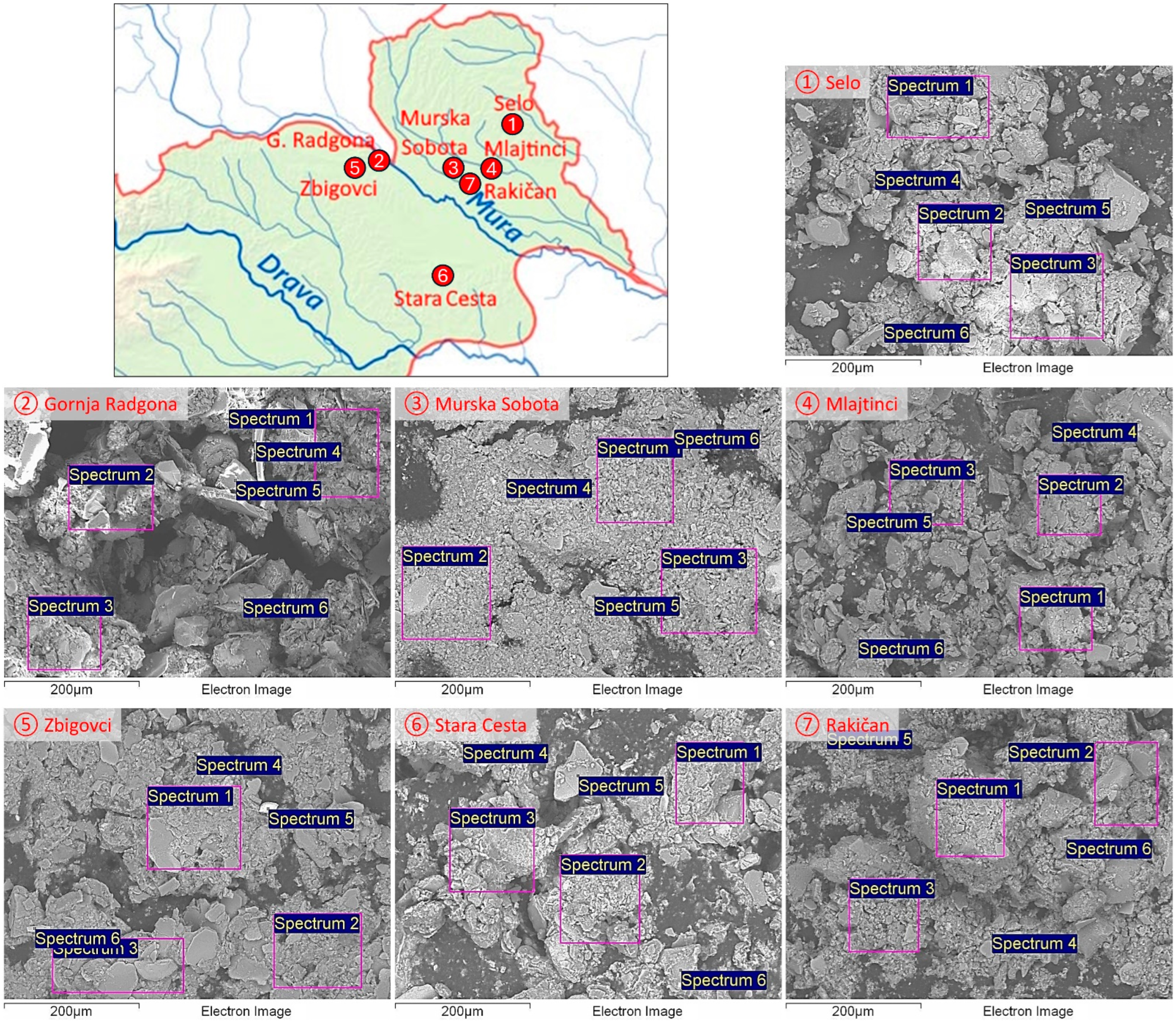
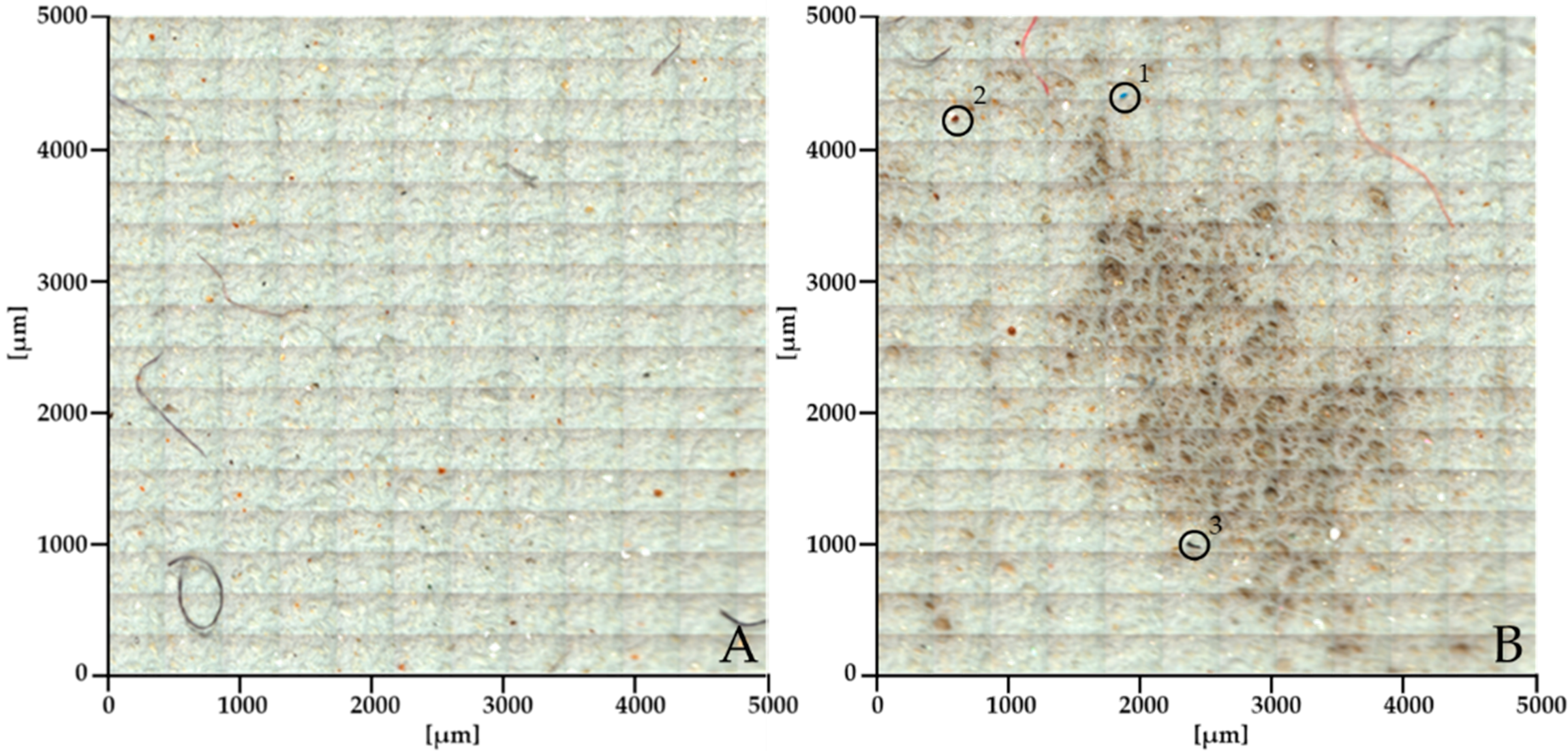
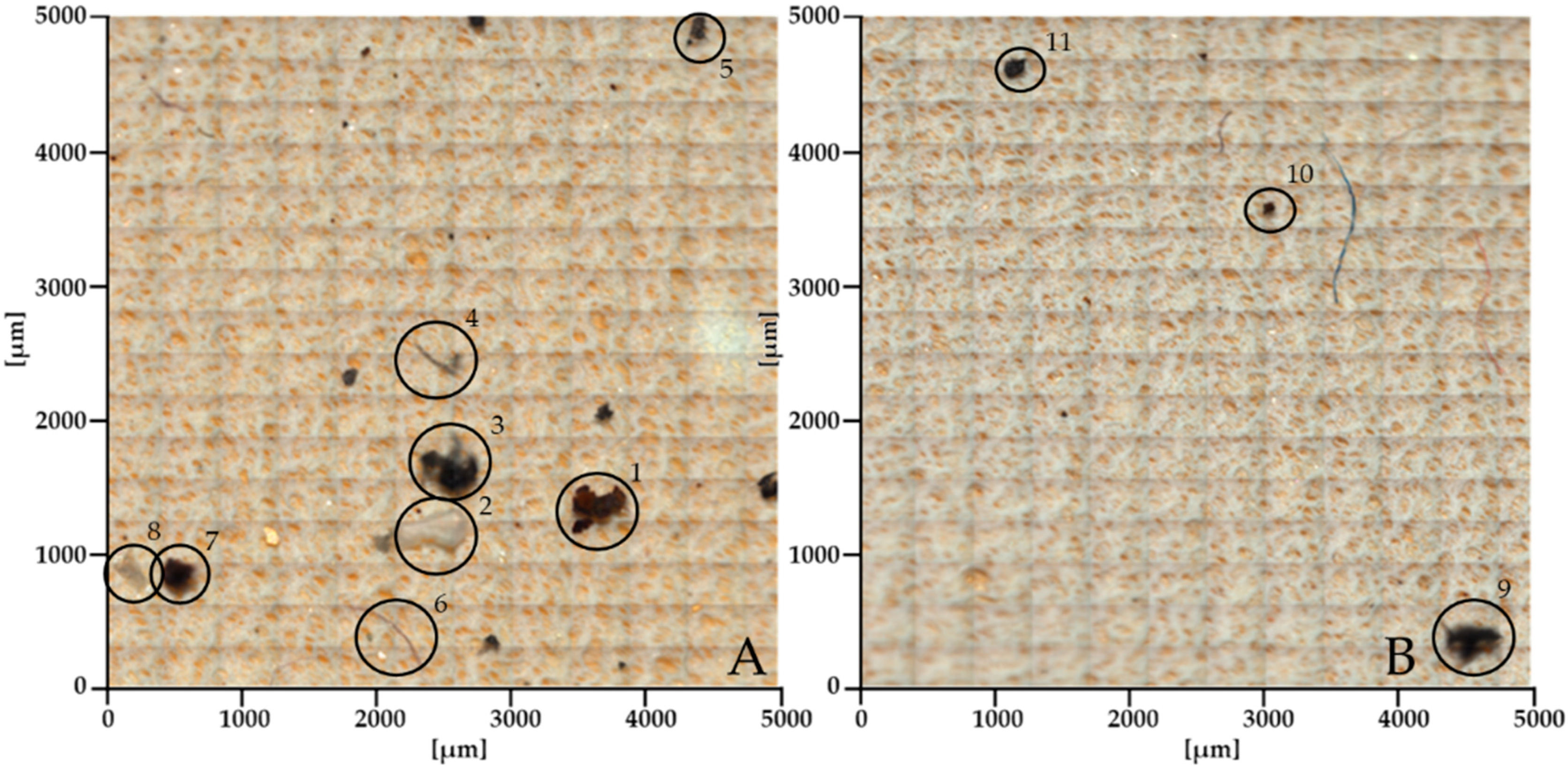

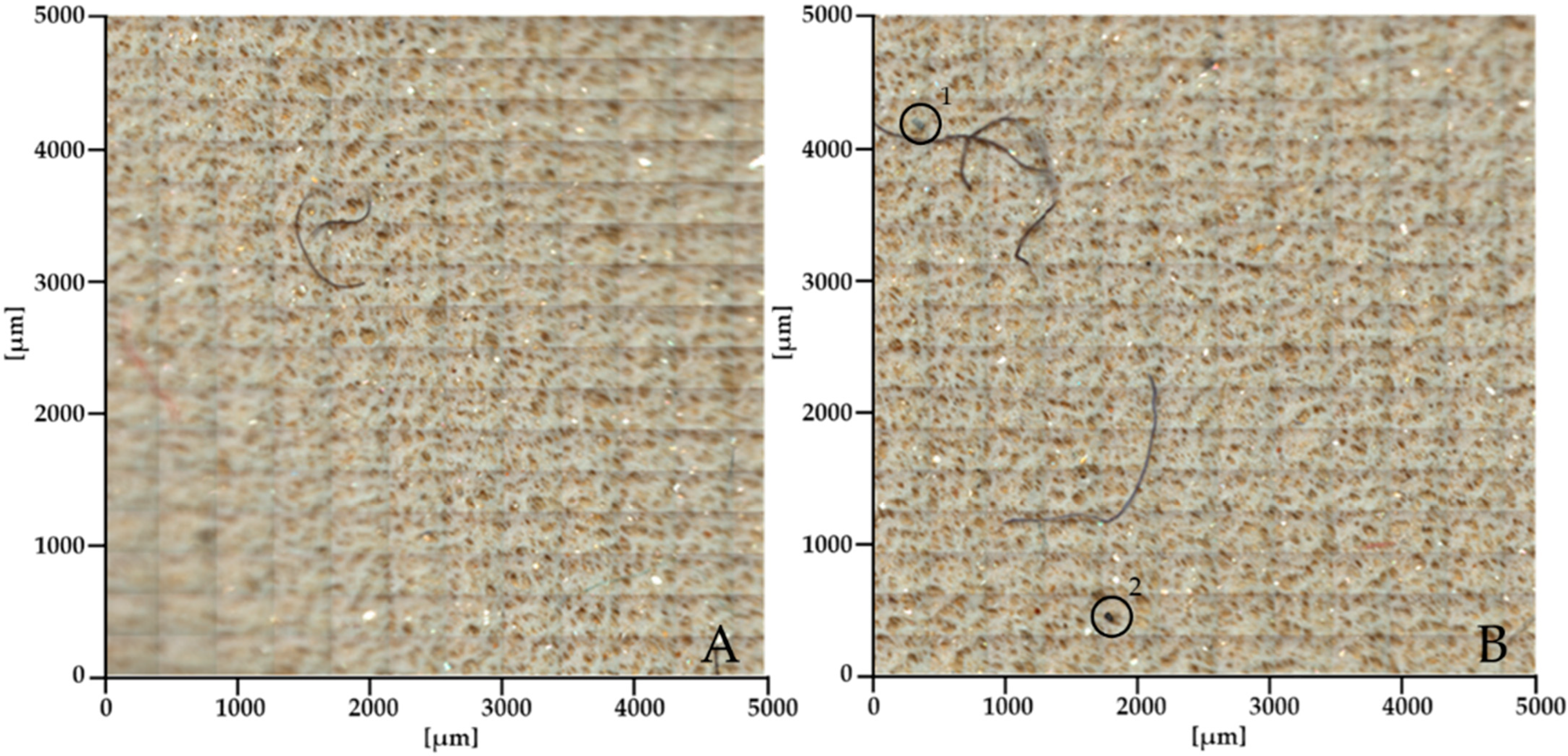


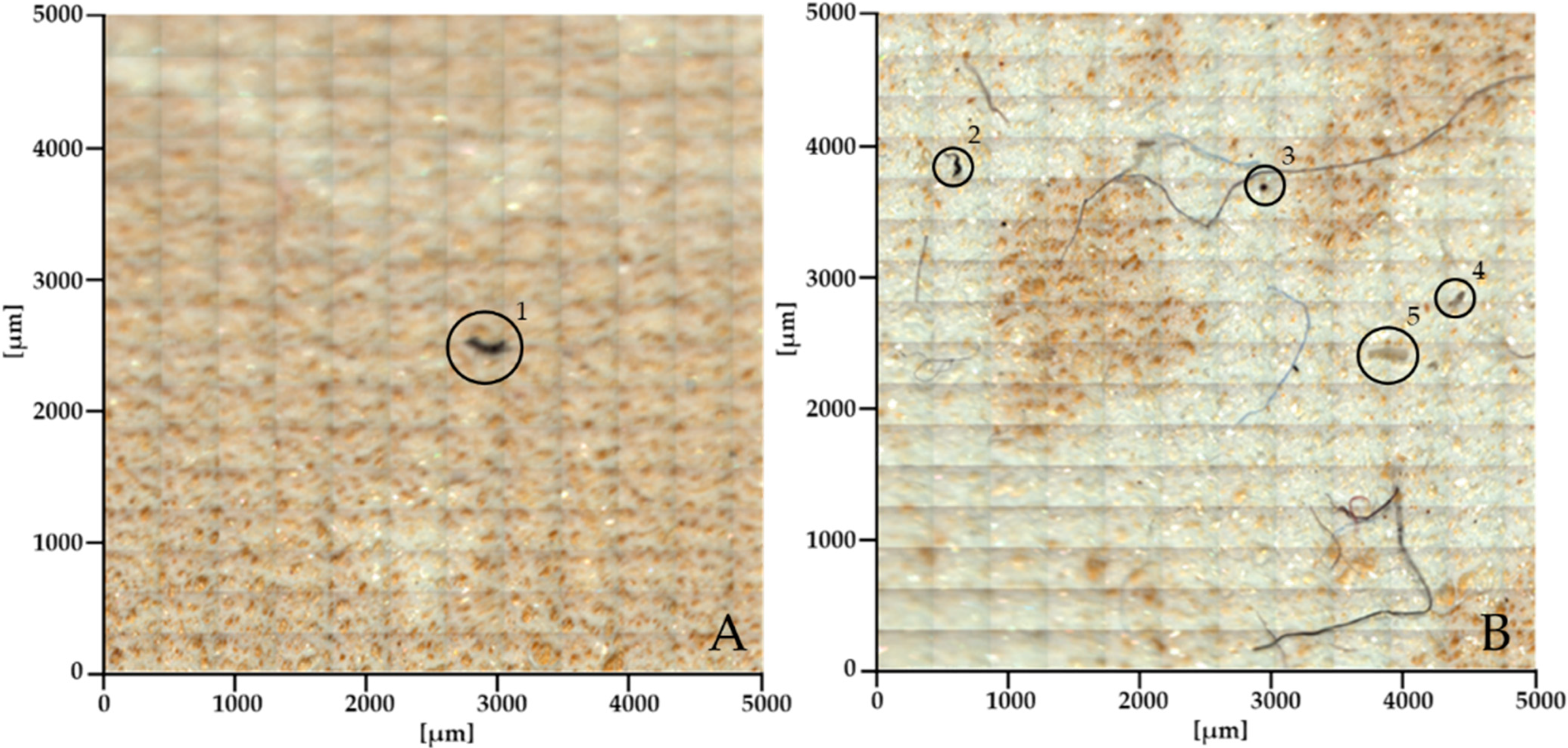

| C | O | Na | Mg | Al | Si | P | K | Ca | Ti | Mn | Fe | Zr | ||
|---|---|---|---|---|---|---|---|---|---|---|---|---|---|---|
| Selo | Mean | 4.57 | 56.16 | 0.56 | 0.73 | 8.91 | 23.30 | 0.00 | 2.39 | 0.29 | 0.16 | 0.00 | 2.95 | 0.00 |
| SD | 3.69 | 4.36 | 1.07 | 0.65 | 4.57 | 6.09 | 0.00 | 2.01 | 0.37 | 0.23 | 0.00 | 2.13 | 0.00 | |
| Max | 11.79 | 68.21 | 5.14 | 2.50 | 17.41 | 42.04 | 0.00 | 9.13 | 1.34 | 0.67 | 0.00 | 8.20 | 0.00 | |
| Min | 0.00 | 50.17 | 0.00 | 0.00 | 0.00 | 16.37 | 0.00 | 0.00 | 0.00 | 0.00 | 0.00 | 0.00 | 0.00 | |
| Gornja | Mean | 11.28 | 49.02 | 0.75 | 1.96 | 6.50 | 16.78 | 0.04 | 1.49 | 2.46 | 0.37 | 0.02 | 9.33 | 0.00 |
| Radgona | SD | 6.42 | 13.55 | 1.05 | 2.41 | 2.83 | 5.84 | 0.13 | 1.40 | 2.98 | 1.58 | 0.11 | 17.36 | 0.00 |
| Max | 21.58 | 61.41 | 3.70 | 9.69 | 11.16 | 32.79 | 0.56 | 6.50 | 11.14 | 7.91 | 0.55 | 83.41 | 0.00 | |
| Min | 0.00 | 0.00 | 0.00 | 0.00 | 0.00 | 0.27 | 0.00 | 0.00 | 0.00 | 0.00 | 0.00 | 0.00 | 0.00 | |
| Murska | Mean | 5.01 | 52.11 | 0.62 | 1.18 | 9.74 | 18.23 | 0.13 | 2.32 | 0.57 | 2.99 | 0.02 | 7.10 | 0.00 |
| Sobota | SD | 4.06 | 6.59 | 0.96 | 0.74 | 3.55 | 5.52 | 0.19 | 1.98 | 1.09 | 9.18 | 0.09 | 7.75 | 0.00 |
| Max | 12.27 | 61.60 | 3.92 | 4.11 | 15.34 | 27.61 | 0.59 | 7.12 | 5.53 | 42.43 | 0.47 | 35.58 | 0.00 | |
| Min | 0.00 | 29.36 | 0.00 | 0.00 | 0.36 | 0.65 | 0.00 | 0.00 | 0.00 | 0.00 | 0.00 | 0.58 | 0.00 | |
| Mlajtinci | Mean | 4.78 | 50.81 | 0.36 | 0.83 | 7.93 | 16.95 | 0.07 | 2.01 | 0.20 | 5.83 | 0.61 | 9.63 | 0.00 |
| SD | 4.95 | 8.81 | 0.76 | 0.47 | 4.02 | 9.74 | 0.19 | 1.83 | 0.30 | 11.31 | 1.74 | 10.31 | 0.00 | |
| Max | 21.18 | 61.06 | 3.14 | 1.77 | 14.67 | 49.23 | 0.73 | 6.66 | 1.13 | 35.25 | 8.05 | 42.00 | 0.00 | |
| Min | 0.00 | 21.72 | 0.00 | 0.00 | 0.42 | 0.91 | 0.00 | 0.00 | 0.00 | 0.00 | 0.00 | 0.00 | 0.00 | |
| Zbigovci | Mean | 9.99 | 49.97 | 0.16 | 0.94 | 7.30 | 14.73 | 0.10 | 1.86 | 0.35 | 2.32 | 0.00 | 8.92 | 3.36 |
| SD | 16.34 | 8.06 | 0.42 | 0.63 | 4.28 | 7.12 | 0.24 | 1.59 | 0.60 | 7.31 | 0.00 | 9.83 | 11.23 | |
| Max | 66.89 | 60.11 | 1.92 | 2.11 | 16.27 | 25.98 | 0.78 | 7.03 | 2.58 | 30.31 | 0.00 | 32.73 | 45.12 | |
| Min | 0.00 | 21.90 | 0.00 | 0.00 | 0.00 | 2.16 | 0.00 | 0.00 | 0.00 | 0.00 | 0.00 | 0.00 | 0.00 | |
| Stara | Mean | 4.40 | 53.57 | 0.30 | 0.95 | 10.26 | 22.01 | 0.02 | 2.25 | 0.16 | 0.31 | 0.00 | 5.75 | 0.00 |
| Cesta | SD | 4.22 | 3.52 | 0.53 | 1.17 | 3.81 | 5.61 | 0.10 | 2.22 | 0.28 | 0.47 | 0.00 | 4.00 | 0.00 |
| Max | 13.60 | 57.68 | 1.72 | 4.66 | 17.92 | 41.80 | 0.50 | 8.08 | 1.03 | 1.92 | 0.00 | 18.53 | 0.00 | |
| Min | 0.00 | 42.51 | 0.00 | 0.00 | 1.55 | 13.49 | 0.00 | 0.00 | 0.00 | 0.00 | 0.00 | 0.73 | 0.00 | |
| Rakičan | Mean | 7.60 | 53.19 | 0.60 | 0.88 | 7.02 | 16.21 | 0.07 | 1.09 | 0.49 | 2.47 | 0.12 | 10.28 | 0.00 |
| SD | 4.53 | 4.79 | 1.31 | 0.63 | 3.12 | 8.54 | 0.18 | 0.82 | 0.63 | 5.87 | 0.49 | 12.78 | 0.00 | |
| Max | 13.71 | 63.94 | 6.30 | 2.39 | 11.45 | 32.59 | 0.70 | 2.96 | 2.86 | 20.92 | 2.45 | 46.37 | 0.00 | |
| Min | 0.00 | 43.24 | 0.00 | 0.00 | 0.84 | 1.10 | 0.00 | 0.00 | 0.00 | 0.00 | 0.00 | 0.62 | 0.00 |
| C | O | Na | Mg | Al | Si | P | K | Ca | Ti | Mn | Fe | Zr | ||
|---|---|---|---|---|---|---|---|---|---|---|---|---|---|---|
| Total | Mean | 6.80 | 52.12 | 0.48 | 1.07 | 8.24 | 18.31 | 0.06 | 1.91 | 0.65 | 2.06 | 0.11 | 7.71 | 0.48 |
| SD | 8.02 | 8.10 | 0.94 | 1.21 | 4.01 | 7.67 | 0.17 | 1.80 | 1.47 | 6.84 | 0.72 | 10.62 | 4.40 | |
| Max | 66.89 | 68.21 | 6.30 | 9.69 | 17.92 | 49.23 | 0.78 | 9.13 | 11.14 | 42.43 | 8.05 | 83.41 | 45.12 | |
| Min | 0.00 | 0.00 | 0.00 | 0.00 | 0.00 | 0.27 | 0.00 | 0.00 | 0.00 | 0.00 | 0.00 | 0.00 | 0.00 |
| C | O | Na | Mg | Al | Si | P | Cl | K | Ca | Ti | Fe | ||
|---|---|---|---|---|---|---|---|---|---|---|---|---|---|
| Apple | Mean | 489.32 | 461.86 | 4.10 | 1.48 | 8.41 | 19.54 | 0.00 | 0.00 | 9.31 | 1.99 | 0.00 | 3.98 |
| SD | 134.52 | 100.35 | 12.45 | 1.62 | 21.38 | 56.06 | 0.00 | 0.00 | 5.96 | 2.34 | 0.00 | 4.90 | |
| Max | 763.60 | 697.40 | 57.70 | 7.00 | 77.00 | 252.30 | 0.00 | 0.00 | 32.50 | 8.60 | 0.00 | 15.80 | |
| Min | 150.80 | 230.30 | 0.00 | 0.00 | 0.00 | 0.00 | 0.00 | 0.00 | 0.00 | 0.00 | 0.00 | 0.00 | |
| Barley | Mean | 521.76 | 396.94 | 1.11 | 1.19 | 0.00 | 40.77 | 0.01 | 5.95 | 27.96 | 1.87 | 0.00 | 2.42 |
| SD | 109.92 | 74.58 | 1.73 | 1.36 | 0.00 | 93.74 | 0.07 | 7.59 | 22.83 | 2.46 | 0.00 | 3.21 | |
| Max | 653.60 | 513.00 | 7.80 | 5.30 | 0.00 | 391.00 | 0.40 | 29.60 | 101.30 | 11.70 | 0.00 | 13.10 | |
| Min | 162.90 | 188.30 | 0.00 | 0.00 | 0.00 | 0.00 | 0.00 | 0.00 | 3.30 | 0.00 | 0.00 | 0.00 | |
| Corn | Mean | 566.45 | 422.61 | 0.80 | 1.80 | 0.00 | 0.00 | 0.00 | 0.00 | 3.40 | 0.65 | 0.00 | 4.31 |
| SD | 65.68 | 65.32 | 0.96 | 3.93 | 0.00 | 0.00 | 0.00 | 0.00 | 3.68 | 0.86 | 0.00 | 12.45 | |
| Max | 709.90 | 511.20 | 3.60 | 20.90 | 0.00 | 0.00 | 0.00 | 0.00 | 14.30 | 3.00 | 0.00 | 67.00 | |
| Min | 483.20 | 283.20 | 0.00 | 0.00 | 0.00 | 0.00 | 0.00 | 0.00 | 0.00 | 0.00 | 0.00 | 0.00 | |
| Potato | Mean | 351.71 | 434.26 | 1.74 | 10.17 | 30.87 | 83.69 | 0.03 | 2.89 | 37.23 | 10.89 | 8.67 | 27.85 |
| SD | 134.26 | 82.33 | 4.26 | 11.22 | 36.28 | 107.84 | 0.15 | 6.23 | 30.35 | 37.84 | 34.81 | 36.82 | |
| Max | 538.90 | 563.70 | 25.80 | 50.80 | 113.60 | 419.50 | 0.90 | 27.90 | 138.40 | 230.50 | 167.00 | 118.30 | |
| Min | 67.40 | 167.30 | 0.00 | 0.00 | 0.00 | 0.00 | 0.00 | 0.00 | 3.90 | 0.00 | 0.00 | 0.00 | |
| Pumpkin seed | Mean | 746.98 | 226.05 | 0.40 | 4.90 | 0.00 | 0.00 | 6.16 | 0.00 | 11.65 | 2.39 | 0.00 | 1.45 |
| SD | 77.78 | 71.11 | 0.66 | 6.55 | 0.00 | 0.00 | 11.43 | 0.00 | 17.79 | 4.98 | 0.00 | 3.02 | |
| Max | 890.70 | 392.50 | 2.50 | 26.00 | 0.00 | 0.00 | 47.80 | 0.00 | 93.20 | 18.60 | 0.00 | 14.30 | |
| Min | 559.80 | 87.90 | 0.00 | 0.00 | 0.00 | 0.00 | 0.00 | 0.00 | 0.00 | 0.00 | 0.00 | 0.00 | |
| Wheat | Mean | 577.83 | 413.33 | 0.80 | 0.90 | 0.00 | 0.00 | 0.13 | 0.00 | 4.56 | 0.78 | 0.00 | 1.70 |
| SD | 62.15 | 58.80 | 1.23 | 1.23 | 0.00 | 0.00 | 0.67 | 0.00 | 5.60 | 1.60 | 0.00 | 3.09 | |
| Max | 677.50 | 507.40 | 4.60 | 4.80 | 0.00 | 0.00 | 3.60 | 0.00 | 22.00 | 7.60 | 0.00 | 15.90 | |
| Min | 490.20 | 320.10 | 0.00 | 0.00 | 0.00 | 0.00 | 0.00 | 0.00 | 0.00 | 0.00 | 0.00 | 0.00 |
| Ash [g/kg dm] | P [g/kg dm] | Mg [g/kg dm] | K [g/kg dm] | Na [g/kg dm] | Fe [mg/kg dm] | Ca [g/kg dm] | |
|---|---|---|---|---|---|---|---|
| Apple | 19.77 | 0.87 | 0.34 | 8.01 | 0.43 | 67.8 | 0.29 |
| Barley | 29.26 | 3.26 | 1.18 | 4.90 | 0.05 | 301.3 | 0.24 |
| Corn | 12.42 | 2.32 | 0.71 | 3.51 | 0.02 | 24.5 | 0.03 |
| Potato | 54.56 | 2.64 | 1.14 | 24.10 | 0.30 | 146.9 | 0.42 |
| Pumpkin seed | 45.15 | 9.97 | 4.30 | 8.34 | 0.06 | 285.0 | 0.21 |
| Wheat | 16.91 | 3.44 | 1.09 | 4.20 | 0.02 | 24.5 | 0.03 |
Disclaimer/Publisher’s Note: The statements, opinions and data contained in all publications are solely those of the individual author(s) and contributor(s) and not of MDPI and/or the editor(s). MDPI and/or the editor(s) disclaim responsibility for any injury to people or property resulting from any ideas, methods, instructions or products referred to in the content. |
© 2024 by the authors. Licensee MDPI, Basel, Switzerland. This article is an open access article distributed under the terms and conditions of the Creative Commons Attribution (CC BY) license (https://creativecommons.org/licenses/by/4.0/).
Share and Cite
Jelen, Ž.; Svetec, M.; Majerič, P.; Kapun, S.; Resman, L.; Čeh, T.; Hajra, G.; Rudolf, R. Contaminants in the Soil and Typical Crops of the Pannonian Region of Slovenia. Sustainability 2024, 16, 8678. https://doi.org/10.3390/su16198678
Jelen Ž, Svetec M, Majerič P, Kapun S, Resman L, Čeh T, Hajra G, Rudolf R. Contaminants in the Soil and Typical Crops of the Pannonian Region of Slovenia. Sustainability. 2024; 16(19):8678. https://doi.org/10.3390/su16198678
Chicago/Turabian StyleJelen, Žiga, Milan Svetec, Peter Majerič, Stanislav Kapun, Lara Resman, Tatjana Čeh, Granit Hajra, and Rebeka Rudolf. 2024. "Contaminants in the Soil and Typical Crops of the Pannonian Region of Slovenia" Sustainability 16, no. 19: 8678. https://doi.org/10.3390/su16198678
APA StyleJelen, Ž., Svetec, M., Majerič, P., Kapun, S., Resman, L., Čeh, T., Hajra, G., & Rudolf, R. (2024). Contaminants in the Soil and Typical Crops of the Pannonian Region of Slovenia. Sustainability, 16(19), 8678. https://doi.org/10.3390/su16198678







